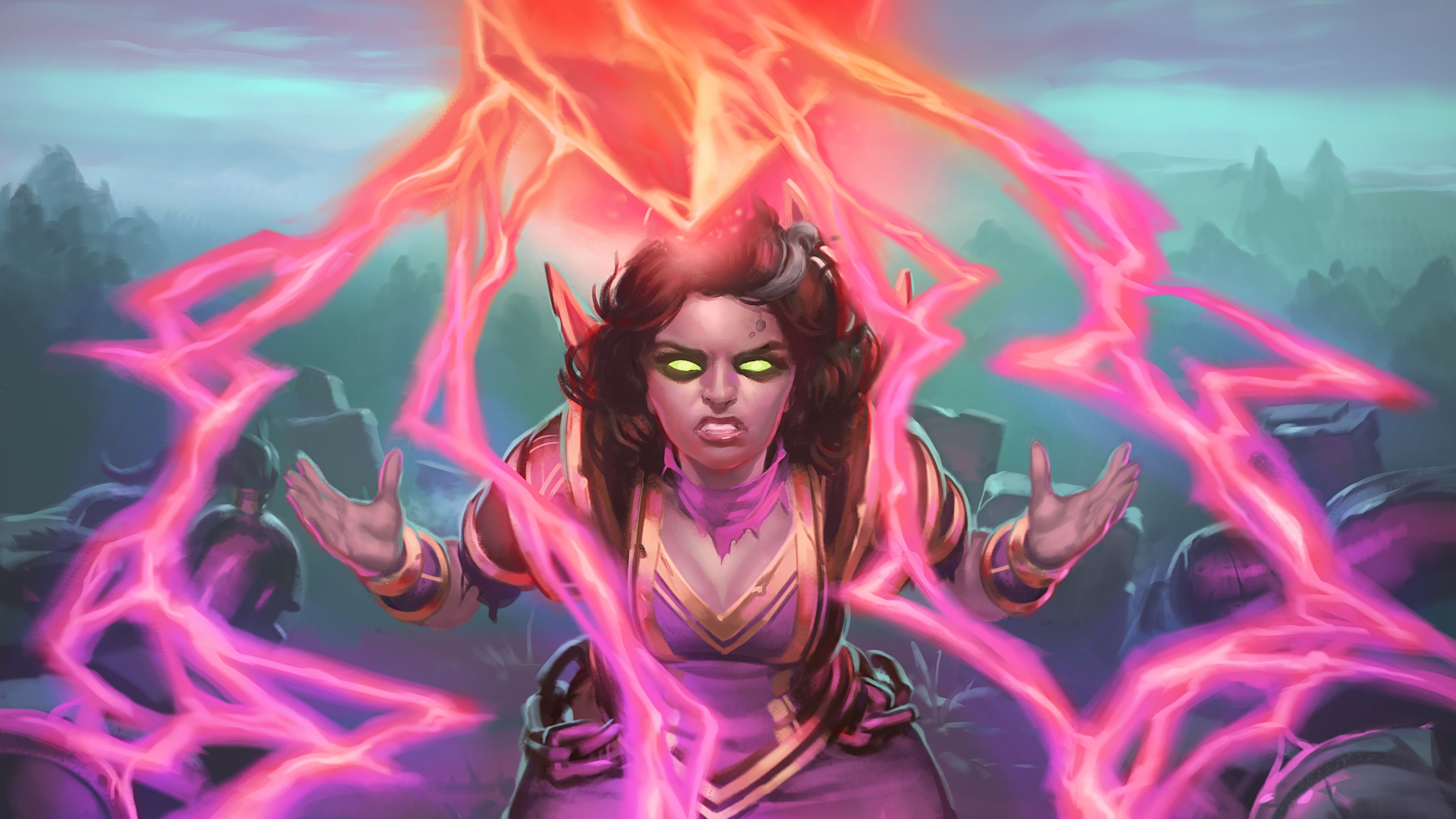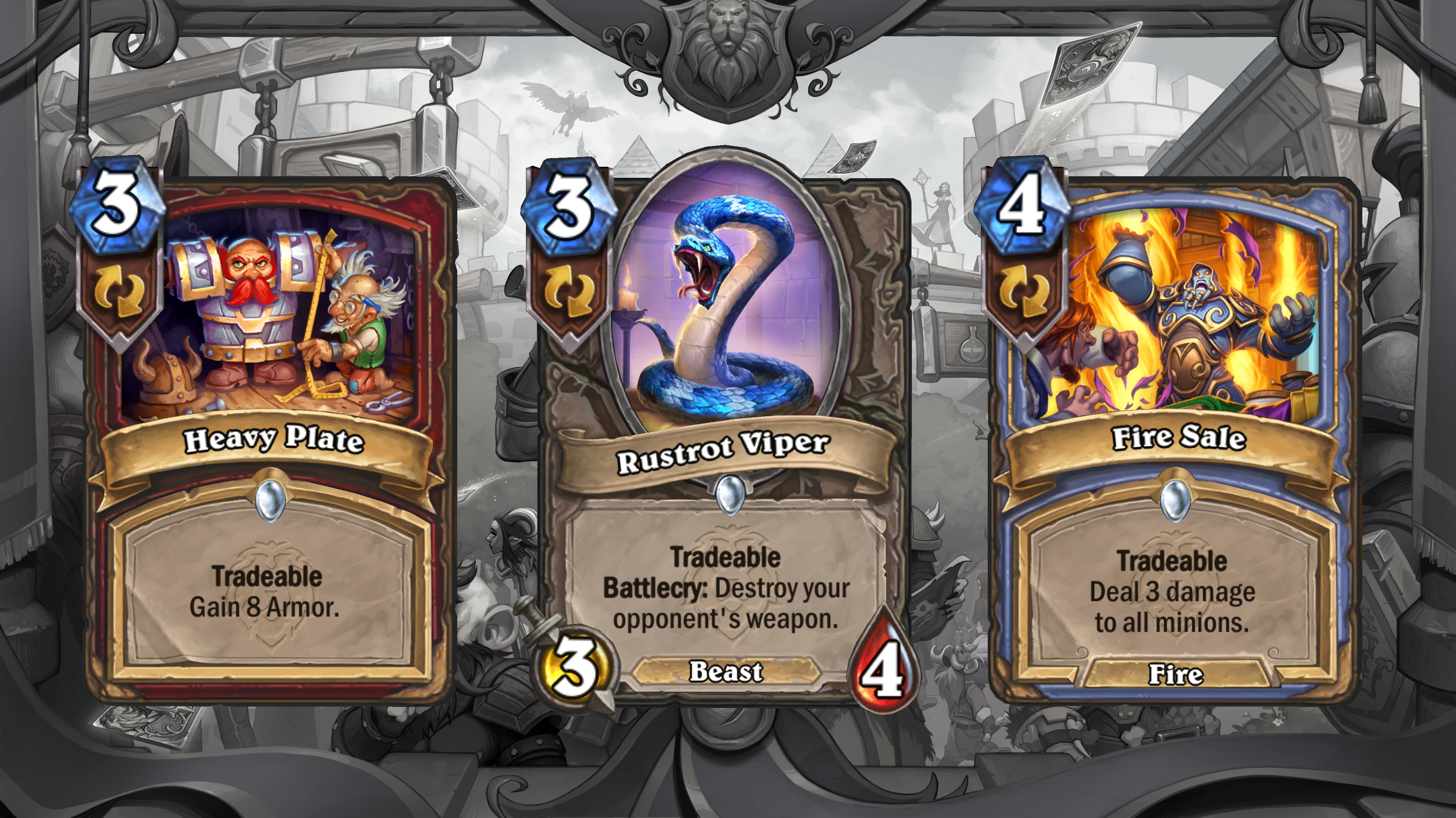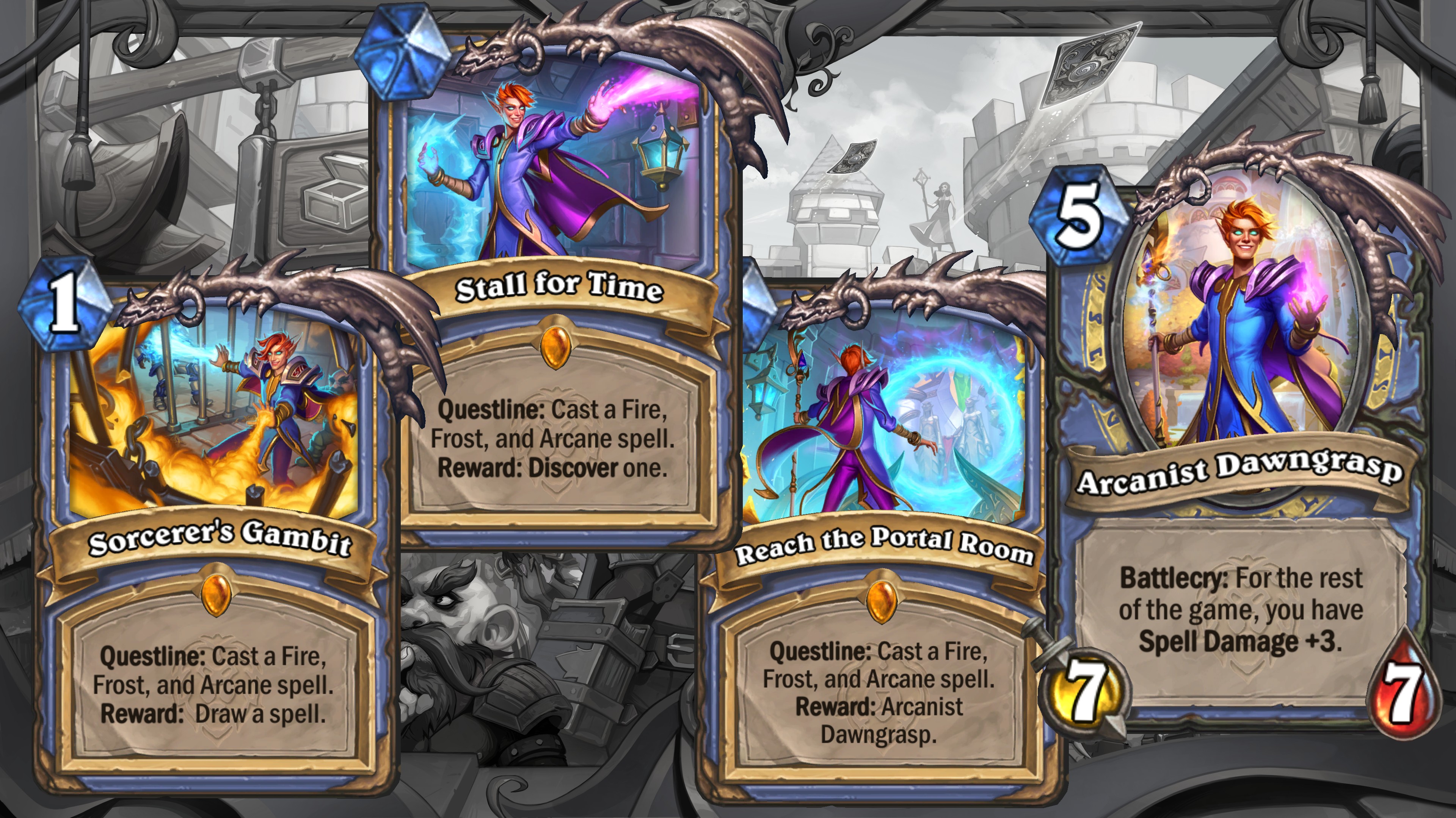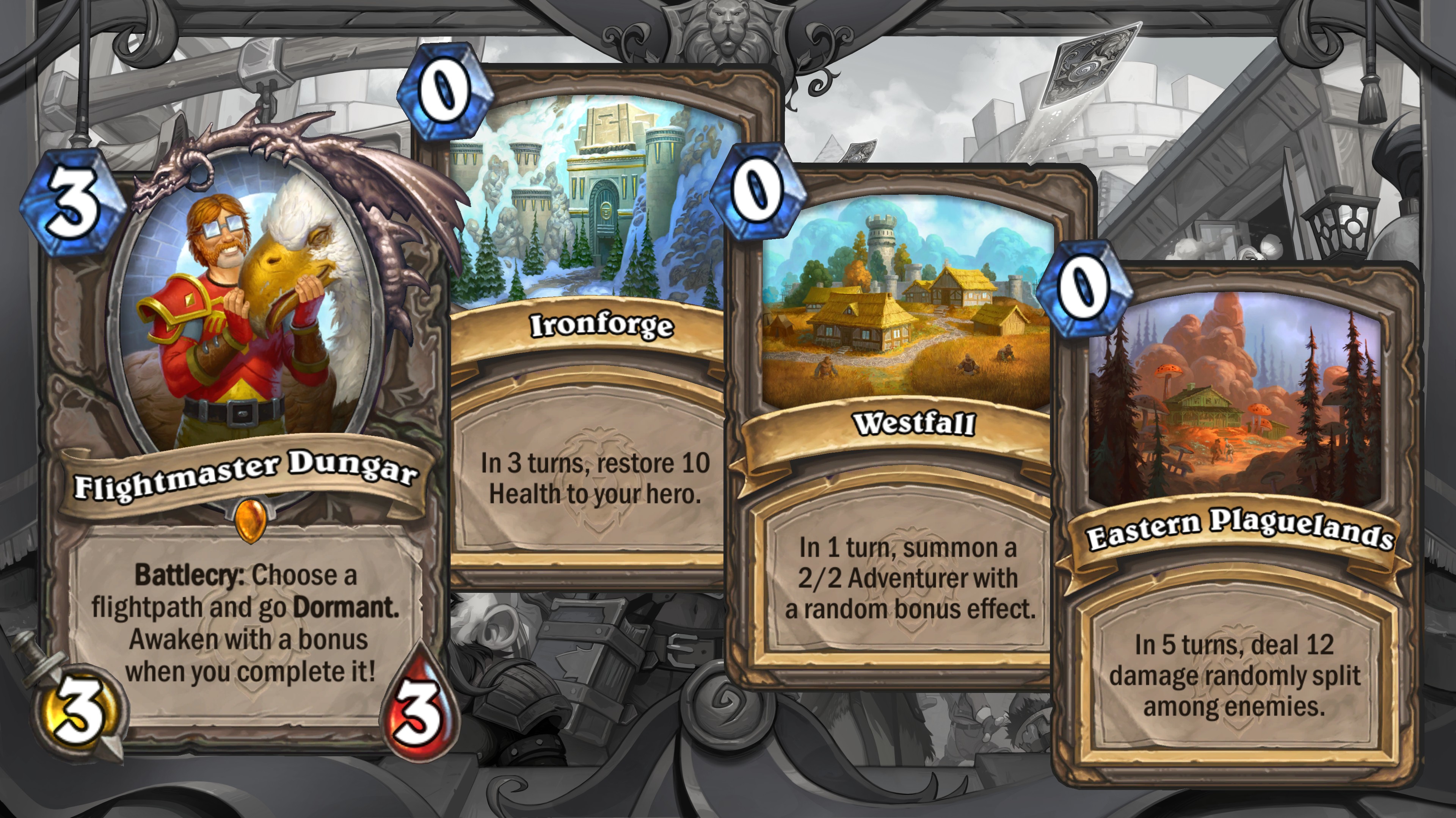Hearthstone devs talk new expansion, how to improve Battlegrounds without breaking it, and the problem with Priest
We also found who was to blame for Sword of the Fallen.

After three months of wandering around the Barrens looking for Mankrik's wife—and frequently being ambushed by angry Mankrik—the next Hearthstone set is almost upon us. For United in Stormwind, which was announced earlier today, we'll be switching sides to visit one of WoW's most iconic cities. The setting will shift from a bleak desert to a bustling hub where players explore professions, trade (with themselves), and find sturdy mounts to accompany them on their next questline. There might even be some cards here to help Priest win games quickly rather than generating infinite value and waiting for the heat death of the universe.
But that wasn't all that was revealed today. Battlegrounds improvements are coming, including the first round of cosmetics and the planned large-scale minion rework to all of the current tribes. It's one of the largest changes the mode has gone through since its initial release and the first wave of updates is starting with the 20.8 patch today. By this time next week, Ragnaros will be our bartender, selling us Amalgadons with a side order of insults.
Earlier this week, we spoke to senior game designer on the Initial Design team Liv Breeden, and associate game designer Cora Georgiou, about what's coming on August 3 when United in Stormwind launches.
PC Gamer: Let's start with the Tradeable cards. When I first read that Hearthstone was doing "tradeable cards", my brain lit up with the idea that players would be able to swap cards with each other. But that's not how they work—instead, we swap cards with our own deck. What was the idea there and the balance considerations with that mechanic?

Liv Breeden: I think one of the things is how we're going from the Barrens, which is this harsh wasteland where characters are just fighting to survive, and we're going to Stormwind—which is the complete opposite. It's an Alliance-based city, full of people and teeming with life. It's really common in World of Warcraft to buy and sell or trade with other people and we wanted to capture that fantasy so we created these cards you could trade away. We wanted to have players trade with themselves during the game so we could design more situational cards.
Heavy Plate's a really good example; sometimes you're a Warrior and you really don't need armor if you're in a control matchup or something like that. You can take cards from your hand that are Tradeable, drag them to your deck, and for 1 Mana get a different card. As far as balance goes, we started these at 0 Mana for the trade effect but that's… really good. We bumped the cost to 1 Mana so there's more weight to the decision. Players can decide if they want to spend the 1 Mana now or save the card in case they need the 8 Armor later.
How would you say it changes the feel of games to have access to this cycling effect?
Keep up to date with the most important stories and the best deals, as picked by the PC Gamer team.
Cora Georgiou: It definitely adds that little bit of extra consistency. If you're playing a deck with situational cards, you can afford to include them or tech pieces since if you're in a circumstance where they aren't super relevant you can just toss them back. And it gave us cool opportunities to make cards that interact with Tradeable cards or improve upon the mechanic as we go forward. It's nice extra reliability in deckbuilding.
LB: It's also comparable to [Druid's] Choose One keyword. Choose One cards are cool because they're versatile and this is a different way to do versatile without impeding upon what Druids do. It's a great way to expand that flexibility to other classes.

It feels like there's been an increasing willingness to print more card draw and let players see more of their decks each game across multiple classes. Is there a philosophical change here from when some classes were really constrained by a lack of draw?
LB: It's a mix of things. On one side of it, there was a point in time where we said "Priest doesn't draw cards as part of their class identity" and Priest just disappeared. Nobody wanted to play the class and it was hard to win with it since you weren't drawing at all. We're adding more of that back into different classes—card games are fun because you get to play the cards in your deck. It's cool that we can restrict resources so you have to play smarter, but it's not as cut and dried as we had it before.
Nobody wanting to play priest, or as I call it, the good old days. Are you at all worried about any player confusion from the mechanic's name and people wondering if Hearthstone is now a trading card game?
LB: It's something that we considered, but I think over time you just get used to it. We think players will realize quickly that it isn't about swapping Tradeable cards with each other—but we still wanted to have this fantasy of being in the city and having cards that are goods or services or shopkeeps.
Can you trade multiple times on a turn?
LB: As long as you have multiple Tradeable cards, yes.
Let's talk about the Questline cards as well. Just to confirm, they start in your hand like the old quests, they have three smaller parts with smaller rewards, and then the final step gets you the new Mercenary card in your hand?
LB: That's correct. You play them like normal quests but they're broken up into three parts—after you complete the first step, it transforms into the second step so you don't need to play it again and you just continue on the journey. Once you've completed all three steps you get a really powerful Legendary minion in your hand that provides big benefits. Some of them are long-term and some of them are one-offs but they're all definitely worth it.

The Warlock reward is a 5-Mana 7/7 with Battlecry: "For the rest of the game, damage you take on your turn damages your opponent instead." You're gonna end games pretty fast!
CG: Yup! We designed these questlines to be built around and they take the vast majority of the game to complete—so we wanted the final piece to be something that one way or another is likely to end the game. If you've played The Demon Seed, you've already taken quite a bit of damage on your own turn to advance it, and you need a lot of healing in your deck to make sure that you simply don't die when you play Blightborn Tamsin. It was important to us that these felt like really powerful pieces that you want to work for. For her, if you're playing a Warlock deck that's [life] tapping, playing Flame Imps, playing Raise Deads… you can certainly end the game with her pretty quickly.
LB: From the designer perspective, it's also really interesting since on old quests if you didn't complete them it's a completely lost resource. With these we can give you a little bit of power along the way to help you complete the Questline— and if not you at least get something out of it and it's less all or nothing. The gameplay is a little more variable that way.
Is there anything else you've learned about this kind of design with a built-in narrative and payoff?

CG: Yeah, absolutely! One of the things is that it's really fun to complete quests. Naturally, if you're completing quests incrementally a little more often, you're getting that moment of excitement, of "oh I did the thing! Now I get paid out for the thing!", and that's naturally going to feel good if it happens more frequently. And of course, you get the big bonus similar to the power level of the previous quests. Like you mentioned, it's also a great opportunity for us to tell a story.
In The Demon Seed, we're telling the story of Tamsin raising the demon Anetheron and bringing him into Stormwind. We get those little bits of lore as we go, and we get to tell the story of our mercenaries—which is really what the whole year is about. It's great to combine narrative and gameplay into a mechanic like that.
LB: We actually started with the concept of Questlines ending with a passive effect so things like [Varden's] permanent Spell Damage +3 for the rest of the game, but there wasn't enough impact to them. You wanted to play those cards and feel like you did the thing, rather than just have the quest turn over and go "yup, we did it". Going from Uldum where quest completion made your hero power change… that's a cool moment, but there's something really special about the original quests where I played the [reward] card and now we're in the second half of the game. The stakes are different now.

Moving onto the mount spells, they bring to mind Spikeridged Steed and I guess Dragonmaw Sky Stalker also has a mount vibe. Why did you think that warranted a keyword and do you have any concern over the mechanic being a bit one-note?
CG: Yeah, they all operate the same way whereby you give a buff and a slight bonus to a minion. The mount that drops off has the exact same stats and same effect. Like you said, it's something that we haven't really done since Spikeridged Steed. If we did it more frequently and it was across every class, it could end up feeling samey, so for that reason we chose to go with fewer classes. The gameplay of Spikeridged Steed was really great and it's one of the most powerful cards in Arena—exploring that across different costs and classes was pretty cool and thematically appropriate.
Flightmaster Dungar really benefits people who know their matchups… What is my game plan and how does it work against my opponent's class?
—Liv Breeden
LB: And there are a lot of spicy cards out there. One thing about World of Warcraft is that everyone remembers getting their mount. It's a big story moment for the mercenaries—this is their mount and this is what makes their mount special. We'll see Warlock and Paladin get their special mounts as well. If you look at Hunter as an example, Immune while attacking is super different from the Taunt from Spikeridged Steed or the Elekk mount.
We're able to diversify a little bit more now that people are familiar with it. We still have simple cards like Elekk that are obvious and people say "oh yeah I get it" right away, but then you look at Ramming Mount and say "this is where it gets interesting".
Can you tell us more about how Flightmaster Dungar works?
CG: Yes, so Flightmaster Dungar is the card that everyone is getting for free in the 20.8 patch that's going out on July 1st. This is really just trying to hard echo a flight master from WoW in Hearthstone. When you play him he'll pop up three different locations for you to choose—Westfall, Ironforge, or the Plaguelands. Depending on the flight path you choose, he'll go dormant for either one turn, three turns, or five turns and the effect of each is different. Again, just one of those really flexible pieces that I think could find use in a lot of different decks.

I like that the giveaway card in each set is kind of a head-scratcher where players can do some weird but cool stuff.
LB: Yeah, and what I like about Dungar is that it really benefits people who know their matchups. Do I need something now, do I want something in five turns… what is my game plan and how does it work against my opponent's class? It really benefits those sorts of players and it's cool!
Tell me a little bit about the philosophy behind the Profession Tools. Do they all interact with the cards in your hand and why was that design space interesting?
LB: So we tried Profession Tools a couple different ways and how we ended up with them is pretty awesome—it's simple enough to understand but still fulfills the fantasy. These are weapons that don't have an attack but have an effect that goes off. For example, Runed Mythril Rod is the enchanting tool. The idea is that you're 'rolling need' on everything and then breaking it all down so you can enchant your other gear. We wanted to get the fantasy of what it was like to do the professions without having to do something like shuffle in crafting materials to your deck or something like that. They're not all hand-based—there's one that's board-based, there's one that's cost-based, and there are other things out there as well.
Next page: The problem with Priest, improving Battlegrounds without breaking it, and who was to blame for Paladin's Sword of the Fallen.
With over two decades covering videogames, Tim has been there from the beginning. In his case, that meant playing Elite in 'co-op' on a BBC Micro (one player uses the movement keys, the other shoots) until his parents finally caved and bought an Amstrad CPC 6128. These days, when not steering the good ship PC Gamer, Tim spends his time complaining that all Priest mains in Hearthstone are degenerates and raiding in Destiny 2. He's almost certainly doing one of these right now.


